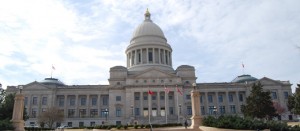 By Steve Brawner, © 2018 by Steve Brawner Communications, Inc.
By Steve Brawner, © 2018 by Steve Brawner Communications, Inc.
By the time this upcoming legislative session is over, taxes in Arkansas undoubtedly will have been cut. The question is, how much will lawmakers learn from Oklahoma’s and Kansas’ mistakes?
Kansas made big tax cuts without corresponding spending cuts thanks to Gov. Sam Brownback’s allegiance to the theory that cutting taxes would stimulate the economy and generate more revenues. Oklahoma cut taxes while relying on oil and gas revenues that fell as those markets tanked.
The result is that Kansas’ budget has been a disaster for years. In fact, it’s Exhibit A when policymakers talk about how not to cut taxes. Finally, in 2017 the Legislature passed more than $1.2 billion in tax increases and then overrode a veto by Brownback, who was determined to keep digging a hole. In November, the longtime Republican state elected a Democrat, Laura Kelly, as governor.
A little closer to home, Oklahoma cut taxes and then dealt with budget issues so severe that almost one in five schools were holding classes four days a week. This year, the governor and Legislature passed a $430 million tax increase to fund education just before teachers staged a nine-day walkout.
One lesson learned is, if you vote for a tax cut today but don’t cut spending enough, then you might really be voting for a tax increase down the road – or at least, forcing someone else to vote for one.
In Arkansas, after passing tax cuts for lower- and middle-income Arkansans the past two sessions, Gov. Asa Hutchinson has proposed gradually reducing taxes on top earners from 6.9 percent to 5.9 percent by 2023. By fiscal year 2021, this will reduce revenues by $111 million.
Meanwhile, a legislative task force has created its own tax cut option that, if fully enacted, could have an even bigger effect on revenues.
The Republican-led Legislature usually follows the Republican governor’s lead. Maybe that will change in his second term, but probably not a lot. Either way, taxes will be cut.
Meanwhile, Hutchinson on Nov. 14 proposed a budget of $5.75 billion for fiscal year 2020, which is $125.2 million more than this year’s budget.
So we’re talking about a tax cut and a small spending increase, in other words.
Let’s emphasize that Arkansas is not Kansas or Oklahoma and certainly is not Washington, D.C. Taxes here the past four years have been cut, not slashed. The governor and the Legislature have moved deliberately. The legislative task force held many months of hearings that included testimony from legislators from Oklahoma and Kansas, as well as North Carolina and Indiana, which cut taxes without creating shortfalls. The task force’s draft legislation includes triggers that would delay the tax cuts if personal income tax collections don’t increase 2 percent, if federal Medicaid funds fall, or if the state’s reserve fund drops. Sen. Jim Hendren, R-Sulphur Springs, the incoming Senate president pro tempore and task force chair, told me legislators don’t want to put future lawmakers in a position of having to raise taxes to close a shortfall.
That’s responsible governance, but of course it must be approved by the entire Legislature. And here’s another concern: Once the taxes are cut, they couldn’t automatically increase if revenues fall and a shortfall is created. That problem would be up to those future lawmakers to fix.
Arkansas’ budget numbers have been adding up these past few years thanks in part to two realities. One, the state has gotten a lot of money from cash-strapped Uncle Sam for health care and a little bit for highways. As the task force acknowledges, that might stop happening.
The second reality is the growing economy, which won’t be growing forever. The current expansion is now almost 10 years old, which means a recession is somewhere around the corner. When that inevitably happens, revenues will tighten and needs will increase.
At that point, tomorrow’s lawmakers will be making decisions while dealing with tax and spending realities created in 2019, when taxes were cut and spending was increased a little.
At this rate, they won’t be in the same boat as those in Kansas and Oklahoma have been lately. But let’s be sure we don’t even get close.
Steve Brawner is a syndicated columnist in Arkansas. Email him at brawnersteve@mac.com. Follow him on Twitter at @stevebrawner.
Can we compare and contrast? In 2011 CA had a budget deficit of 27 Billion dollars. Jerry Brown was elected governor and to office in January 2012. The citizens of CA voted to raise the income taxes on millionaires followed by predictions of gloom and doom. All the wealthy people would leave CA. Since January 2012, more wealthy people have moved into CA than have moved out of CA. CA also voted to increase the gas tax 12 cents per gallon. They are now in the midst of a building boom on roads and mass transit. The state with the healthiest economy today is CA. The 27 Billion dollar deficit? Today CA has a 9 billion dollar surplus.